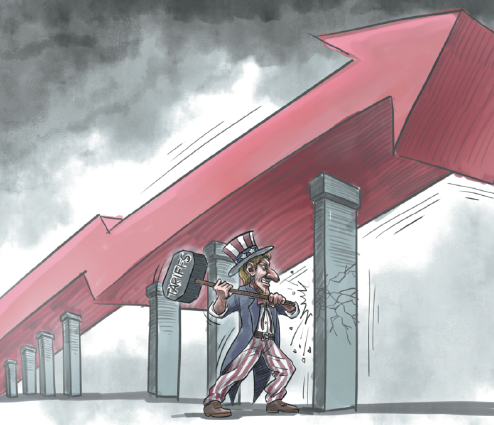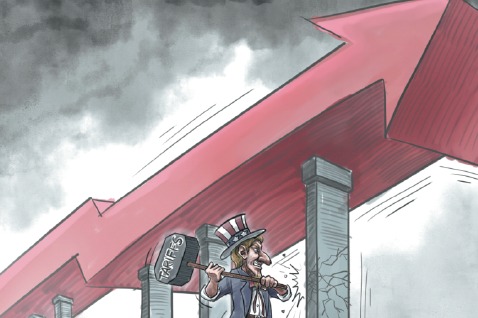US-China ties could improve under realistic Trump


The United States' policy toward China is confused and will likely remain so for years to come. US politicians have a lazy and largely ignorant view of the world. They believe that the US is at the center of the world system and that other countries must pay deference to the US. Since the US is not at the center of the world system, there is a glaring difference between Washington's view of the world and the reality. This difference leads to tensions and even wars.
This difference is not likely to be resolved during the Donald Trump administration, so the coming years will be complicated. At the same time, Trump is likely to prove to be more realistic, and therefore more oriented toward diplomacy, than was his predecessor, Joe Biden.
World leader of global convergence
The basic issue is this. We are in an age of economic convergence, in which developing countries are narrowing the economic gap with the richer countries. This is because developing countries have the policy tools to achieve rapid growth. China is the world leader of global convergence. According to various measures of science and technology, China has largely closed the gap with the US and Europe in overall scientific output and cutting-edge technology in many areas.
Other developing regions, such as ASEAN and India, are also achieving rapid advancement in their economy and technology, though not quite at the pace that China achieved during 1980-2020. Africa, too, is likely to make rapid advances in the next 40 years, albeit from a low average base today.
From the early 1800s until today, the US developed a sense of cultural, economic, and technological superiority over other countries. This great confidence reflected some remarkable accomplishments. The US had the world's largest economy by around 1890, and achieved remarkable breakthroughs in industrial production and many areas of science and technology, such as the creation of the transistor in 1947, the moon landing in 1969, the microprocessor in 1971, the early development of the internet in the 1960s and 1970s, and the recent advances in artificial intelligence.
Still, the US was far from alone in making these accomplishments. Many breakthroughs came from other parts of the world, and many US innovations were vastly improved upon by advances made in other countries. Nonetheless, arrogance became an abiding part of US foreign policy and the cause of many US foreign policy blunders and failures.
US' failure to read global economic trend
After the end of World War II, it seemed to US political leaders that the US had only one potential rival for global power, the Soviet Union. US leaders believed the US would eventually overwhelm the Soviet Union through the US dominance in science, technology, the economy and finance. The US was briefly frightened by the Soviet Union's launch of the Sputnik satellite in 1957. It acknowledged the power of the Soviet nuclear arsenal, too, yet American leaders believed the US would eventually dominate the Soviet Union. When the Soviet Union disintegrated into 15 successor states in 1991, the belief in the US' permanent global dominance took over Washington.
What the US politicians did not appreciate was the process of economic convergence. In the 1960s, Japan and several neighboring countries in East Asia achieved remarkably rapid growth. Starting in the late 1970s, China began the greatest large-scale growth spurt in history. By the 1990s, India and Southeast Asian countries began to achieve rapid economic growth. The US' share of global output measured at international prices (or purchasing power parity) fell from 22 percent in 1980 to 15 percent in 2024(according to the International Monetary Fund estimates). During the same period, China's share of global output increased from 2 percent to 19 percent.
Starting around 2010, US political leaders began viewing China's economic rise as a threat to the US' global dominance, and beginning around 2014, Washington started to use its old anti-Soviet "containment" playbook to try to hinder China's continued advance. The US took several steps, including building more trade barriers against and limiting the flow of technology to China, and increasing the US military presence around China's maritime perimeter in the East China Sea, South China Sea and Indian Ocean trade routes.
Biden's false belief in US supremacy
Joe Biden is a politician who largely lived in the past during his presidency, repeating old 1990s' nostrums about the US' indispensable role in the world. The Russia-Ukraine conflict was the result of Biden's belief in America's continued primacy. The US' idea was to expand NATO eastward to surround Russia in the Black Sea region, just as the US has built up its military assets in East Asia.
Yet Russian President Vladimir Putin drew a bright red line against NATO extending to Ukraine and Georgia. Biden refused to heed Putin's red lines, leading to the conflict. At the core of Biden's actions was his mistaken belief that the combination of US economic sanctions, financial power and NATO's weaponry would soon overwhelm Russia. Of course, this na?ve thinking proved wrong.
The US has played a similar kind of game vis-à-vis Taiwan, by continuing to increase arms sales to the island despite Beijing's strong objections. Once again, US arrogance is at play: the belief that the US does not have to heed the red lines of others, including Beijing. Fortunately, Washington has been more cautious in dealing with Beijing than with Moscow, though US policies vis-à-vis Taiwan have been provocative and dangerous.
The return of Trump to the White House will change the dynamics but not end the tensions between the US and China. Trump is much more of a realist than Biden and will respect China's power more than Biden did. We already see Trump's realism playing out vis-à-vis Russia. Trump will try to help end the Russia-Ukraine conflict by stopping the US' long-standing effort to extend NATO to Ukraine and Georgia. He rightly respects Russia's power, understands that Biden vastly overestimated the US' power, and sees no benefit in continuing to gamble with a weak hand. In the same way, Trump will probably avoid an escalation of tensions with Beijing over Taiwan.
Exaggerated vision of Washington's power
Yet Trump and his team still seem to have exaggerated visions of the US' power and ability to shape events to serve its narrow ends. Washington seems to believe, for example, that it can sustain its lead in technological development over China by restricting the flow of US technologies to that country. As DeepSeek shows, however, this is very unlikely to be the case. China's science and technology sector is booming and cannot really be stopped by the US. Of course, there is no valid reason for the US to even try to do so.
Trump similarly overestimates the importance of the US market to China's exporters and thereby surmises that the threat of US tariffs and other trade barriers will terrify the country's competitors. The US market is very important for neighboring Canada and Mexico, and for a few other countries, but is far less important for most of the world, including China. The US market accounts for about 71 percent of Canada's merchandise exports to the world, and nearly 76 percent of Mexico's exports, but only about 13 percent of China's total exports, and a measly 1 percent of Russia's.
Chinese exporters have been facing headwinds in the US market for many years, and the US market is no longer a source of export growth for China. The value of China's exports to the US in US dollar terms has declined by about 20 percent from the peak year in 2018. The US' trade barriers have no doubt slowed China's overall economic growth, but not very significantly, and China's obvious strategy is to develop strong export markets in emerging economies. This is already happening. The US also has little leverage through financial policy and sanctions. The role of the dollar in international trade and finance is diminishing, and if the US continues to weaponize the dollar, the dollar's role will fall even faster.
Salutary realism beneficial to all
Trump has recently broached the idea of a three-way arms control negotiation with China and Russia. This is a wonderful idea, and could significantly reduce global tensions, lower the risks of nuclear war, and reduce military costs for all three countries. It could be a key signal that Trump is more realistic about the need for cooperation with China than is the rest of Washington. Such realism would be salutary indeed and could greatly stabilize international relations.
In sum, although Washington continues to view Beijing as a threat and to overestimate the US economic and technological power and leverage, relations among the major powers could improve in the coming years even as the US becomes more protectionist in trade, finance and technology. In the long run, such economic protectionism will hurt the US far more than China, Russia and other economies, but at least it would probably not spill over into open military conflict.
The author is director of the Center for Sustainable Development at Columbia University.
The views don't necessarily reflect those of China Daily.
If you have a specific expertise, or would like to share your thought about our stories, then send us your writings at opinion@chinadaily.com.cn, and comment@chinadaily.com.cn.
































